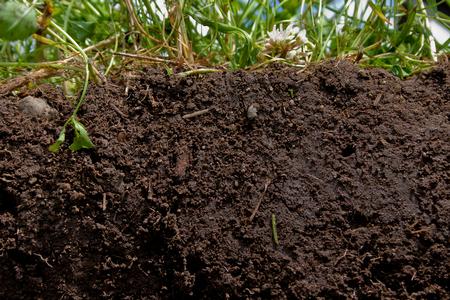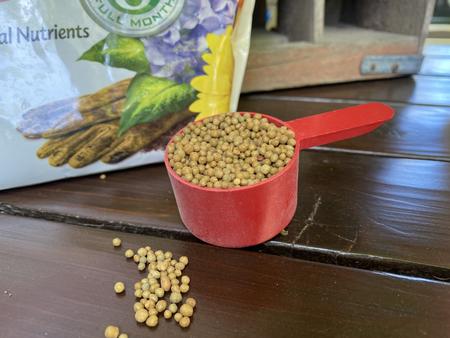Soil improvements and preparation

Soil Types
- Sandy soil is coarse textured and has good drainage, but it retains very little water or nutrients. It is easy to work and irrigate.
- Loam and sandy loam soils are of medium texture, easy to irrigate, and usually drain well. These soils are easy to work.
- Clay soil is fine textured and usually more fertile and productive than other soil. However, clay soil compacts easily, so it drains slowly. It must not be worked when very wet, and it crusts when dried out. If wet, it takes longer to warm up in the spring.
Soil in good physical condition (good tilth) can hold and provide adequate quantities of nutrients, water, and air to plant roots. It will also drain well when large quantities of water are applied, and it will be easy to work without becoming sticky when wet and crusted when dry.
Improving Soil Tilth
If your garden soil has poor tilth, it can be improved by adding organic matter, such as compost, manure, sawdust, leaves, lawn clippings, or peat moss. Be careful to avoid excessive amounts of organic matter: for example, large quantities of manure can cause excessive salt build-up. Never use lawn clippings recently treated with pesticides. Additional nitrogen fertilizer may be needed when organic matter is used. Cover crops or green manures, such as rye, oats, and wheat, can also improve the condition of soil when they are tilled under in fall or spring. To produce these crops in time for fall or spring tilling, sow seed in early fall.
The first step in soil preparation is spading, rototilling, or plowing the garden. Do not till the soil if it is too wet, especially if it is clay. In some areas, it is possible to give the garden an early spading before winter rains or frosts occur. If it is not possible to work the soil before winter rains, prepare it as soon as it is dry enough to work easily without resulting in compaction. Work the soil to a depth of at least 6 inches. Immediately after spading, break up large clods with a spading fork or rake to ensure that the soil is pulverized into pea-sized granules. Soil can be formed into beds at this time if desired.
Fertilizing before planting

If you use manure, apply it several weeks or even months before planting and work it well into the soil. This usually allows adequate time for the manure to decompose and some of the manure salts to leach from the surface soil before seeding or transplanting. Adding 1 pound of dry steer or dairy manure per square foot of soil surface is usually sufficient. If you use dry poultry manure, which is more concentrated, apply it more sparingly (1 lb to 4 or 5 sq ft). If you use manure that contains litter (straw, shavings, sawdust, or similar materials), also apply nitrogen fertilizer to avoid tying up nitrogen already present in the soil as well as that being added as manure.
Commercial fertilizers are available in a wide variety of compounds and concentrations. If you use manure or other organic materials, the usual commercial fertilizer need is for nitrogen alone. Nitrogen fertilizers suitable for home garden use include alfalfa meal, cottonseed meal, ammonium sulfate, calcium nitrate, and urea. Limit the application of these materials to 1/2 to 1 pound per 100 square feet whenever they are used.
If you do not apply manure or other organic matter, it is usually wise to apply a fertilizer that contains both nitrogen and phosphorus before planting. Ammonium phosphate (16-20-0 or 11-48-0) is one such material.
Other commonly used inorganic fertilizers, which contain also potassium, include 5-10-5, 5-10-10, 8-16-16, and 12-12-12. Apply about 1 to 2 pounds per 100 square feet whenever these materials are used, but do not exceed 1 1⁄2 to 2 ounces (1/10 lb) of actual nitrogen per 100 square feet.
You can apply fertilizer either by broadcasting it before preparing the seedbeds or in bands at seeding time. If you broadcast the fertilizer, work it into the soil fairly soon to prevent nitrogen losses through ammonia volatilization. Sometimes banding is a more efficient way to use fertilizer. To band a fertilizer, determine where you are going to plant the seed or plants. Then mark the row with a small furrow or a string tied from one end of the row to the other. Dig a shallow trench 2 to 4 inches to one side of the row and 2 to 4 inches below where the seed is to be placed. Place the fertilizer in the bottom of the trench and cover it with soil. To use furrow irrigation, place the fertilizer band between the seed or plant row and the irrigation furrow. To irrigate by sprinkler, band fertilizer on either side of the row. Use 1 to 2 pounds of fertilizer per 100 feet of row.
Suggested Application Rates for Fertilizers (applied before planting)
| AMOUNTS PER 1,000 SQUARE FEET Approximate Volume (dry-processed) |
|||
| Organic Materials | |||
| Pounds | Cubic Feet | Gallons | |
| Blood meal | 20-25 | 1/2 | 3 |
| Bone meal | 20-30 | 1/3-1/2 | 21/2-3 |
| Fish meal | 20-30 | ||
| Poultry, goat, sheep, or rabbit manure* | 100-125 | 21/2 -3 | 18-20 |
| Steer, dairy, hog, or horse manure* | 300-400 | 71/2-10 | 60-75 |
| Inorganic Materials | |||
| Pounds | Pints | ||
| Ammonium nitrate | 4-5 | 5-6 | |
| Ammonium sulfate | 7-8 | 7-8 | |
| Urea | 3-4 | 4-5 | |
| Single superphosphate | 10-12 | 8-10 | |
| Potassium sulfate | 4-5 | 21/2-31/2 | |
| Ammonium phosphate (16-20-0) | 9-10 | 9-10 | |
| 12-12-12 | 12-15 | 11-14 | |
| 16-16-16 | 9-10 | 8-9 | |
| 19-9-0 | 7-8 | 7-8 | |
* Caution should be used when using manure to avoid bacterial contamination on edible plant parts
Source: Pests of the Small Farm and Garden, p. 14. Originally from Hunter Johnson, 1985. Fertilizing Vegetable Gardens. UC Riverside, Mimeo.
